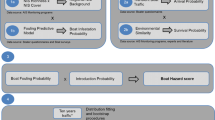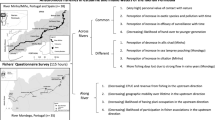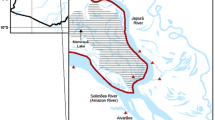Abstract
Despite an increased understanding of marine invasions, non-indigenous species (NIS) continue to be redistributed at both global and regional scales. Since prevention is an important element of NIS programs, monitoring vectors responsible for NIS introductions and spread, such as hull fouling, has become a priority and methods should be selected carefully to balance accuracy, time, and cost. Two common fouling assessment tools for the marine recreational boating vector were evaluated for accuracy using a traditional underwater SCUBA survey in coastal British Columbia: a dockside level of fouling assessment and a behavioral questionnaire model. Results showed that although rapid, dockside assessments did not provide an accurate assessment of fouling present below the surface, at least not in this region. In contrast, a questionnaire-based model using four easily obtained variables (boat type, age of antifouling paint, storage type, and occurrence of long distance trips) reliably identified boats carrying macrofouling species, a proxy for risk of NIS transport. Once validated, this fouling model tool could be applied in border inspection or quarantine situations where decisions must be made quickly. Further development and refinement of rapid assessment tools would improve our ability to prevent new introductions and manage spread of existing invasive species.


Similar content being viewed by others
References
Andersen MC, Adams H, Hope B, Powell M (2004) Risk assessment for invasive species. Risk Anal 24(4):787–793
Ashton G, Boos K, Shucksmith R, Cook E (2006) Risk assessment of hull fouling as a vector for marine non-natives in Scotland. Aquat Invasions 1:214–218
Australian Quarantine and Inspection Services (2006) New biofouling laws to protect Australia. www.aqis.gov.au/yachts. Accessed 7 Nov. 2007
Bossenbroek JM, Johnson LE, Peters B, Lodge DM (2007) Forecasting the expansion of zebra mussels in the United States. Conserv Biol 21:800–810
Campbell ML, Gould B, Hewitt CL (2007) Survey evaluations to assess marine bioinvasions. Mar Pollut Bull 55:360–378
Carlton JT, Ruiz GM (2005) Vector science and integrated vector management in bioinvasion ecology: conceptual frameworks. In: Mooney HA, Mack RN, McNeely JA, Neville LE, Schei PJ, Waage JK (eds) Invasive alien species. Island Press, Washington, pp 36–58
Christie AO, Dalley R (1987) Barnacle fouling and its prevention. In: Southward AJ (ed) Barnacle biology. A.A. Balkema, Rotterdam, pp 419–433
Clarke Murray C, Pakhomov EA, Therriault TW (2011) Recreational boating: a large unregulated vector transporting marine invasive species. Divers Distrib 17:1161–1172
Clarke Murray C, Therriault TW, Martone PT (2012) Adapted for invasion? Evaluating attachment strength, drag and dislodgment for marine non-indigenous. Biol Invasions. 22 pp. doi:10.1007/s10530-012-0178-0
Cohen AN, Carlton JT (1998) Accelerating invasion rate in a highly invaded estuary. Science 279(5350):555–558. doi:10.1126/science.279.5350.555
Cohen A, Mills C, Berry H, Wonham M, Bingham B, Bookheim B, Carlton J, Chapman J, Cordell J, Harris L, Klinger T, Kohn A, Lambert C, Lambert G, Li K, Secord D, Toft J (1998) A rapid assessment survey of non-indigenous species in the shallow waters of Puget Sound. Washington State Department of Natural Resources United States Fish and Wildlife Service, p 37
Cohen AN, Harris LH, Bingham BL, Carlton JT, Chapman JW, Lambert CC, Lambert G, Ljubenkov JC, Murray SN, Rao LC, Reardon K, Schwindt E (2005) Rapid assessment survey for exotic organisms in southern California bays and harbors, and abundance in port and non-port areas. Biol Invasions 7:995–1002
Coutts ADM (1999) Hull fouling as a modern vector for marine biological invasions: investigation of merchant vessels visiting northern Tasmania. Thesis, Australian Maritime College. 283 pp
Coutts ADM, Taylor MD (2004) A preliminary investigation of biosecurity risks associated with biofouling on merchant vessels in New Zealand. NZ J Mar Freshw Res 38:215–229
Coutts ADM, Piola RF, Taylor MD, Hewitt CL, Gardner JPA (2010) The effect of vessel speed on the survivorship of biofouling organisms at different hull locations. Biofouling. J Bioadhesion Biofilm Res 26(5):539–553. doi:10.1080/08927014.2010.492469
Darbyson EA, Locke A, Hanson JM, Willison JHM (2009) Marine boating habits and the potential for spread of invasive species in the Gulf of St. Lawrence. Aquat Invasions 4:87–94
Davidson I, Sytsma M, Ruiz G (2006) Preliminary investigations of biofouling of ships’ hulls: non-indigenous species investigations in the Columbia River. Coast Guard Research and Development Center A602554. 75 pp
Davidson IC, McCann LD, Fofonoff PW, Systma MD, Ruiz GM (2008) The potential for hull-mediated species transfers by obsolete ships on their final voyages. Divers Distrib 14:518–529
Davidson IC, Zabin CJ, Chang AL, Brown CW, Sytsma MD, Ruiz GM (2010) Recreational boats as potential vectors of marine organisms at an invasion hotspot. Aquat Biol 11:179–191
Drake DAR, Mandrak NE (2010) Least-cost transportation networks predict spatial interaction of invasion vectors. Ecol Appl 20:2286–2299
Floerl O (2002) Intracoastal spread of fouling organisms by recreational vessels. Dissertation, James Cook University
Floerl O, Inglis GJ (2003) Potential for the introduction and spread of marine pests by private yachts In: Godwin LS (ed) Hull fouling as a mechanism for marine invasive species introductions: proceedings of a workshop on current issues and potential management strategies. February 12–13, 2003, Honolulu, Hawaii, pp 22–28
Floerl O, Inglis GJ (2005) Starting the invasion pathway: the interaction between source populations and human transport vectors. Biol Invasions 7:589
Floerl O, Inglis GJ, Hayden BJ (2005a) A risk-based predictive tool to prevent accidental introductions of nonindigenous marine species. Environ Manage 35:765–778
Floerl O, Inglis GJ, Marsh HM (2005b) Selectivity in vector management: an investigation of the effectiveness of measures used to prevent transport of non-indigenous species. Biol Invasions 7:459–475
Floerl O, Inglis GJ, Dey K, Smith A (2008) The importance of transport hubs in stepping-stone introductions. J Appl Ecol 46:37–45
Fofonoff PW, Ruiz GM, Steves B, Carlton JT (2003) In ships or on ships? Mechanisms of transfer and invasion for nonnative species to the coasts of North America. In: Ruiz GM, Carlton JT (eds) Invasive species: vectors and management strategies. Island Press, Washington, pp 152–182
Francis G (2001) Introduction to SPSS for Windows. Pearson Education Australia, Sydney
Godwin LS (2003) Hull fouling of maritime vessels as a pathway for marine species invasions to the Hawaiian Islands. Biofouling 19:123–131
Gollasch S (2002) The importance of ship hull fouling as a vector of species introductions into the North Sea. Biofouling 18:105–121
Grey EK (2009) Do we need to jump in? A comparison on two survey methods of exotic ascidians on docks. Aquat Invasions 4:81–86
Havenhand JN, Svane I (1991) Roles of hydrodynamics and larval behaviour in determining spatial aggregation in the tunicate Ciona intestinalis. Mar Ecol Prog Ser 68:271–276
Hayes KR (2003) Biosecurity and the role of risk assessment. In: Ruiz G, Carlton JT (eds) Invasive species: vectors and management strategies. Island Press, Washington, DC, pp 382–414
Hayes KR, Hewitt CL (2000) Quantitative biological risk assessment of the ballast water vector: an Australian approach. Marine bioinvasions: proceedings of a conference January 24–27, 1999. MIT Sea Grant College Program 00, pp 370–386
Hopkins GA, Forrest BM (2010) A preliminary assessment of biofouling and non-indigenous marine species associated with commercial slow-moving vessels arriving in New Zealand. Biofouling: J Bioadhesion Biofilm Res 26:613
Johnson LE, Padilla DK (1996) Geographic spread of exotic species: Ecological lessons and opportunities from the invasion of the zebra mussel Dreissena polymorpha. Biol Conserv 78:23–33
Johnson LE, Ricciardi A, Carlton JT (2001) Overland dispersal of aquatic invasive species: a risk assessment of transient recreational boats. Ecol Appl 11:1789–1799
Levings C, Kieser D, Jamieson GS, Dudas S (2002) Marine and estuarine alien species in the Strait of Georgia, British Columbia. In: Alien invaders in Canada’s waters, wetlands, and forests. Natural Resources Canada, pp 111–131
Lewis PN, Hewitt CL, Riddle M, McMinn A (2003) Marine introductions in the Southern Ocean: an unrecognized hazard to biodiversity. Mar Pollut Bull 46:213–223
Lu L, Levings CD, Piercey GE (2007) Preliminary investigation on aquatic invasive species of marine and estuarine macrobenthic invertebrates on floating structures in five British Columbia harbours. Can Manuscr Rep Fish Aquat Sci 2814. 30 pp
MacIsaac HJ, Borbely JVN, Muirhead JR, Graniero PA (2004) Backcasting and forecasting biological invasions of inland lakes. Ecol Appl 14:773–783
Minchin D, Gollasch S (2003) Fouling and ships’ hulls: how changing circumstances and spawning events may result in the spread of exotic species. Biofouling 19:111–122
Minchin D, Floerl O, Savini D, Occhipinti-Ambrogi A (2006) Small craft and the spread of exotic species. In: Davenport JL, Davenport J (eds) The ecology of transportation: managing mobility for the environment. Springer, Berlin, pp 99–118
Mineur F, Johnson MP, Maggs CA (2008) Macroalgal introductions by hull fouling on recreational vessels: seaweeds and sailors. Environ Manage 42:667–676
Padilla DK, Chotkowski MA, Buchan LA (1996) Predicting the spread of zebra mussels (Dreissena polymorpha) to inland waters using boater movement patterns. Glob Ecol Biogeogr Lett 5:353–359
Pederson J, Bullock R, Carlton J, Dijkstra J, Dobroski N, Dyrynda P, Fisher R, Harris L, Hobbs N, Lambert G, Lazo-Wasem E, Mathieson A, Miglietta M, Smith J, Smith III J, Tyrrell M (2005) Marine invaders in the northeast: Rapid assessment survey of non-native and native marine species of floating dock communities, August 2003. MIT Sea Grant College Program Publication 05-03. 40 pp
Piola RF, Conwell C (2010) Vessel biofouling as a vector for the introduction of non-indigenous marine species to New Zealand: Fishing vessels. Prepared for MAF Biosecurity New Zealand 08-10840. 57 pp
Ruiz GM, Fofonoff PW, Steves B, Foss SF, Shiba SN (2011) Marine invasion history and vector analysis of California: a hotspot for western North America. Divers Distrib 17:362–373
Wonham MJ, Carlton JT (2005) Trends in marine biological invasions at local and regional scales: the Northeast Pacific Ocean as a model system. Biol Invasions 7:369–392
Zar JH (1999) Biostatistical analysis. Prentice Hall, Inc., Upper Saddle River
Acknowledgments
The authors are grateful to the marina operators and boat owners for allowing access to their facilities and boats. We thank the following for field and lab assistance: N. Backe, F. Choi, T. Goodman, B. Hill, M. Mach, C. Simkanin, A. Stevenson, and J. Yu. We thank M. Herborg, L. Brown, and three anonymous reviewers for reviewing earlier drafts. Our thanks to the Canadian Aquatic Invasive Species Network (CAISN) for providing conference travel support. This research was funded in part by a grant from the Invasive Alien Species Partnership Program, a Government of Canada initiative, the Aquatic Invasive Species program of Fisheries & Oceans Canada and a National Science and Engineering Research Council (NSERC) Postgraduate Scholarship to CCM.
Author information
Authors and Affiliations
Corresponding author
Rights and permissions
About this article
Cite this article
Clarke Murray, C., Therriault, T.W. & Pakhomov, E. What Lies Beneath? An Evaluation of Rapid Assessment Tools for Management of Hull Fouling. Environmental Management 52, 374–384 (2013). https://doi.org/10.1007/s00267-013-0085-x
Received:
Accepted:
Published:
Issue Date:
DOI: https://doi.org/10.1007/s00267-013-0085-x




